The truth is that sensitive skin is not a type. A skin type is an identity assignment. It is a constant that remains the same through the majority of the client’s life, although its characteristics may change subtly with the seasons or with aging from the time the skin reaches its maturity to its advanced age. Even then, certain type characteristics might remain the same!
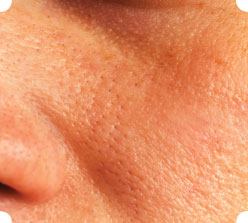 Oily Skin Example
Oily Skin Example
If a child is destined to have oily skin, early signs may manifest during preadolescence, as hormonal activity begins to stew. Skin that was smooth, supple, and soft may now show visible pores in the corners of the nose or T-zone and oiliness upon waking in the morning. Fast forward a few years when the child becomes a teenager with full-blown acne. During young adulthood, while the acne might have subsided, pores are still visible and the appearance or feeling of oiliness still presents in the morning upon waking and later in the day. Well into middle adulthood, oiliness may decrease, but since oily skin is thicker than other skin types, fewer fine lines and wrinkles may be noticed in comparison to their contemporaries with dry skin. Later in life, their skin continues to age less noticeably. Some oiliness might appear at times, but is less apparent than their earlier years. Although the characteristics of oily skin manifest differently at different times during their life, this person’s skin is always oily.
Sensitive Skin from Birth
Everyone is born with sensitive skin. A baby’s skin is highly reactive to both external stimuli, such as detergents, fragrances, and weather, as well as internal stimuli, such as food allergens or viral infections. The reason for this sensitivity is because a baby’s immune system takes time to develop. Furthermore, all babies develop at different rates, depending on how many stimuli or triggers they were exposed to on a regular basis, both in the home and through the diet. Babies also are often born with remaining hormones and potentially high levels of candida albicans yeast from their mothers. The hormones and yeast can manifest on the skin as milia (baby acne), eczema in crevice areas and the stomach, cradle cap, thrush, and yeast infections on the bottom. However, as the immune system matures and the child grows, these symptoms occur less and less.
Sensitive Skin as a Condition
Sensitive skin is a condition, much like acne or rosacea, with many potential causes and triggers. It is not something that can be treated with products or aesthetic treatments if the causes and triggers remain in the client’s diet, skin care regimen, or lifestyle. While there are many definitions of holistic skin care, it is typically agreed upon that a holistic approach looks at the whole picture and the whole person. This approach looks at various areas such as the person’s skin care regimen, diet, lifestyle, environment, stress levels, health history, relationships, emotional health, self-image, and spiritual practices.
Unlike other conditions, like acne, eczema, or melasma, a holistic approach to sensitive skin is necessary because it is not something that a dermatologist would necessarily diagnose as a skin disease and prescribe medication for treatment (unless another condition is present like rosacea). This is great news for skin care professionals because, unlike other skin conditions, there are fewer scope of practice issues, assuming that other underlying skin or health conditions have been ruled out.
Sensitive skin manifests in different ways, including dry and peeling skin, breakouts on a client who does not normally have acne, itchiness, inflamed rashes, swelling and flaky red rashes around the eyes, hives, and more. These reactions could be the result of prolonged contact to a substance or external factor, causing localized sensitization, irritation, phototoxicity, or allergic reactions. It can also be caused by something internally, such as a food sensitivity, intolerance or allergy, cumulative sensitization due to overexposure to certain ingredients, toxic build up, circulatory or lymphatic stagnation, or gut dysbiosis.
Gut Dysbiosis
Gut dysbiosis occurs when the balance of beneficial bacteria, yeasts, and other microflora in the gastrointestinal track is overcome by the over-proliferation of pathogenic bacteria, fungi, and yeasts. Poor diet and digestion, inadequate elimination, lack of physical activity, and stress are the most common circumstances that can lead to gut dysbiosis. Gut dysbiosis is responsible for sensitivity in the entire body which might appear as chronic infections or diseases, autoimmune diseases, mental or emotional imbalance or illness, and skin diseases or sensitivity. A 2011 study revealed the specific connection between gut health and skin health, as well as the direct effects of stress on the microbiomes of the gut and the skin.1
 Detective Work Begins in the Treatment Room
Detective Work Begins in the Treatment Room
While it is not in the scope of a skin care professional’s practice to treat a compromised gut by identifying skin sensitivity and asking key questions in the treatment room, a professional can help the client recognize certain skin triggers and make more targeted referrals to holistically-minded professionals – like health coaches, integrative and functional nutritionists or physicians, naturopathic physicians, and acupuncturists – who can do further work to identify exactly what the triggers are and help that client eliminate them.
One of the first questions asked during a client consultation is usually along these lines: “What brings you here today?” or “What is your main skin concern right now?” If the client replies that their skin has really been sensitive lately or that they feel like everything is making their skin react negatively, then an excellent opportunity has arisen to open a dialogue and start finding potential clues.
Once sensitivity is suspected, either upon client consultation or skin analysis, the professional can ask the following questions:
What types of reactions have you been noticing on your skin? How long has this been going on? Has anything changed in your home or work environment lately, such as a move, new skin care products or detergent, new pet, trouble with the boss or co-workers, or working overtime? On a scale from one to 10, 10 being the highest, how would you rate your stress level? Do you regularly eat foods containing sugar, dairy, or gluten (these are common skin triggers)? Have you noticed if these reactions are worse at certain times of day or after eating certain foods? Do you wear perfume or use products containing fragrances in your personal care regimen or household cleaning products? Have you ever been tested for allergies or sensitivities to foods, animals, mold, dust, pollen, or something else?
The purpose of asking these questions is not to cross-examine the client or render a diagnosis – it is simply to help the client begin the thought process of being more aware of different potential triggers in their diet, lifestyle, and environment. It also encourages the client to be more self-aware and mindful of what is going on with their own body.
A person with sensitive skin is likely sensitive in other areas of life, whether physically or emotionally. Therefore, it is important for the skin care professional to show compassion to that client, treat their skin delicately, and encourage them to show the same level of compassion with their home care regimen.
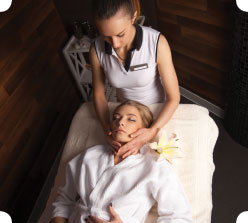 Important Considerations for Clients with Sensitive Skin
Important Considerations for Clients with Sensitive Skin
Go easy on the ambiance. Treatment rooms often play soft music, diffuse essential oils, light candles, and employ other ambiance-enhancing methods to improve the client experience. Clients with sensitive skin may also be prone to sensory overload, so watch the client’s body language for signs of overstimulation and turn something off if necessary. It might seem obvious to ask the client if the ambiance is okay, but not everyone with underlying sensitivities is aware of them. Furthermore, from a mindset perspective, the client may want to be okay with everything or worry about insulting or inconveniencing the professional. Therefore, the client may not admit that something was too much. On the other hand, other hypersensitive individuals might instantly go into overdrive and have an emotional outburst about the ambiance.
Avoid steam and excessive friction. Like rosacea, sensitive skin does not respond well to excessive heat or friction. The combination of the heat and moisture from a steamer might induce a claustrophobic response in a sensitive client; too much friction from a facial massage might cause redness, inflammation, or actual pain on the surface of the client’s skin. Furthermore, certain sensitive clients are also reactive to being touched and may become stressed from a massage on the scalp, face, neck, shoulders, and décolletage. Warm towels are a better solution for softening pores and acupressure is a great alternative to facial massage.
Keep exfoliation to a minimum or eliminate it completely. The question of whether to exfoliate or not to exfoliate is asked quite frequently. However, it is generally not a good idea to exfoliate clients with sensitive skin as it often has a compromised barrier function. Acids, scrubs, dermafiles, microdermabrasion, and other types of exfoliation can make sensitive skin worse and could cause further damage to the skin’s barrier and immune functions. Light enzyme exfoliation might even be too much for sensitive clients. Use great care and discretion or skip this step completely.
Avoid mechanical stimulation. Cleansing brushes, vacuums, electrotherapy, dermaplaning, and microneedling should not be used on sensitive skin.
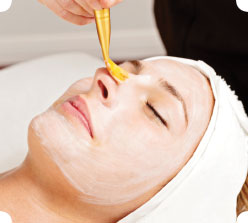 Treating Sensitive Skin
Treating Sensitive Skin
When treating a client with sensitive skin, professionals should use products that are free of synthetic fragrances, surfactants, and other irritant ingredients. They should also choose products with simple formulations. Products with long ingredient decks that are filled with strong performance ingredients and botanical actives can easily cause sensitive skin to react. Natural products with simple, whole-plant formulations are ideal. Regardless of what products are used in the spa, it is helpful to always have a back-up back bar of simply-formulated products for sensitive clients.
In place of steam and essential oils, use a Lucas sprayer with cooling and anti-inflammatory herbal teas. Sensitive skin often benefits more from cooling than from heat; herbal teas are much less concentrated than essential oils and less likely to cause sensitization. Professionals can also offer Reiki in place of massage if they are attuned. This switch can help balance the energy of a nervous, sensitive person, helping them to benefit more from their treatment. When utilizing a mask, use soothing and cooling cream or aloe-based masks rather than a drawing or drying clay mask.
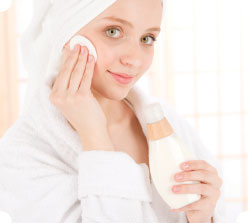 Holistic Homecare and Referral Recommendations
Holistic Homecare and Referral Recommendations
It is important that clients understand that a gentle approach is necessary for treating sensitive skin at home. It is also important that they follow the homecare version of the guidelines above. They should also follow these referral and environmental recommendations:
While at home, clients should avoid super-hot showers, cleansing brushes, scrubs, and harsh towels. They should cleanse their skin either with the hands and tepid water or a soft bamboo washcloth and gently pat dry with a soft towel.
Homecare products should have simple formulations, short ingredient decks, no fragrances, and no surfactants. The professional's goal should be to soothe and nourish the client's skin. Recommendations to the client can be as simple as a jojoba oil cleansing oil, rosewater toner, and argan oil serum.
Professionals should also encourage the use of natural mineral makeup (if the client wears makeup) and the replacement of liquid products every three to six months, checking expiration dates. Educate the client about highly specific allergy and sensitivity tests that exist outside of what a typical allergist might perform. These tests identify sensitivities, allergies, and intolerances that may not show up on a typical immunoglobuten E test, but could still trigger systemic and skin sensitivities. A functional or integrative doctor or nutritionist, as well as a naturopathic physician, can administer and interpret these tests and create a customized dietary plan, taking the results into consideration.
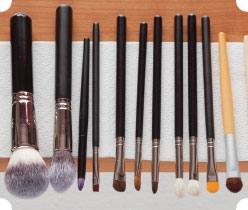 Encourage the client to try an elimination diet under the supervision of a certified health coach or nutritionist. These professionals may also recommend a cleanse, the addition of fermented foods and/or probiotic supplements, and other dietary supplements.
Encourage the client to try an elimination diet under the supervision of a certified health coach or nutritionist. These professionals may also recommend a cleanse, the addition of fermented foods and/or probiotic supplements, and other dietary supplements.
Have clients make sure that their heating and air conditioning vents and filters are cleaned seasonally and that they have their home assessed for mold. Furthermore, clients should utilize air and water filters. Indoor air pollution, as well as chlorine and other toxins in tap water, can contribute to skin sensitivity. While whole house water filters are preferred, shower and faucet filters are acceptable alternatives.
Encourage the regular cleaning of makeup brushes and regular changing of sheets, towels, and washcloths. These objects can harbor skin-sensitizing bacteria, mold, and other microbes.
A key role of the skin care professional is to teach clients that the skin is a messenger, not an enemy that must be attacked or a child that must be punished for misbehaving. The skin also serves as the body’s greatest protector; like any strong armor, it must be handled with great care to avoid chinks or other weak spots. Sensitivity is a condition, not a type. Once the triggers have been eliminated and the immune system has resumed normal functioning, it often goes away and does not come back. What a significant difference that makes in the client’s life!
References
1. Bowe, Whitney P. and Alan C. Logan. (2011). Acne Vulgaris, Probiotics and the Gut-brain-skin Axis - Back to the Future? Gut Pathogens. 3(1).
 Rachael Pontillo is the bestselling author of Love Your Skin, Love Yourself, and co-author of the cookbook, The Sauce Code. She is an award winning AADP board certified holistic health and image coach, certified metaphysical practitioner, licensed aesthetician, natural skin care formulator and educator. She is the creator of the popular blog and lifestyle site, www.holisticallyhaute.com, and the six-week online course, Create Your Skincare™. Pontillo is a recipient of the Institute for Integration®’s esteemed Health Leadership Award and is also a brand ambassador and spokesperson for NeoCell™. Pontillo is currently working towards a Ph.D. in Holistic Life Counseling.
Rachael Pontillo is the bestselling author of Love Your Skin, Love Yourself, and co-author of the cookbook, The Sauce Code. She is an award winning AADP board certified holistic health and image coach, certified metaphysical practitioner, licensed aesthetician, natural skin care formulator and educator. She is the creator of the popular blog and lifestyle site, www.holisticallyhaute.com, and the six-week online course, Create Your Skincare™. Pontillo is a recipient of the Institute for Integration®’s esteemed Health Leadership Award and is also a brand ambassador and spokesperson for NeoCell™. Pontillo is currently working towards a Ph.D. in Holistic Life Counseling.
Want to read more?
Subscribe to one of our monthly plans to continue reading this article.